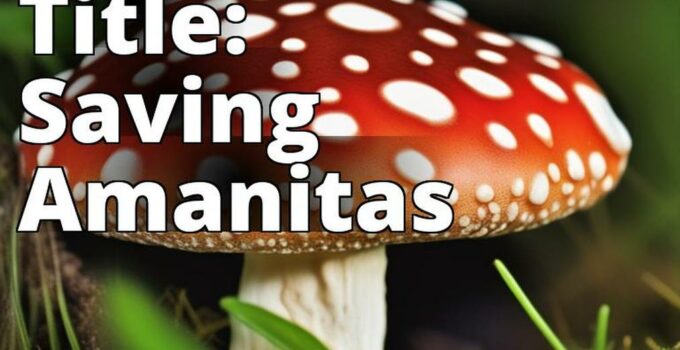Are you aware of the importance of Amanita mushroom conservation efforts? Amanita mushrooms are a crucial component of the natural ecosystem, playing a vital role in maintaining ecological balance. They have medicinal benefits and cultural significance but unfortunately are facing numerous threats that are leading to their extinction. In this article, we will discuss the importance of Amanita mushroom conservation efforts, the threats they face, current and future conservation efforts, challenges faced in conservation, and expert opinions.
Amanita Mushroom Overview
Amanita mushrooms are a genus of fungi that are characterized by their distinctive cap, which is often brightly colored and covered with white or yellow warts. These mushrooms have a stem and gills on the underside of the cap, which produce spores. Some species of Amanita mushrooms are edible, while others are highly toxic and can cause serious illness or death.
There are over 600 species of Amanita mushrooms, and they can be found in various habitats worldwide. Some of the most common species include the fly agaric (Amanita muscaria), the destroying angel (Amanita bisporigera), and the death cap (Amanita phalloides). It is essential to note that some species, such as the death cap, are highly toxic and can cause severe liver damage and even death if ingested.
Amanita mushrooms play a crucial role in the food chain, as they are decomposers that break down organic matter and release nutrients into the soil. They also form symbiotic relationships with trees and other plants, exchanging nutrients for sugars produced by the plant through photosynthesis.
Amanita Mushroom Conservation Efforts
- Amanita mushrooms play a crucial role in maintaining ecological balance and have medicinal benefits.
- Over-harvesting, habitat loss, climate change, and pollution are the main threats to Amanita mushrooms.
- Conservation efforts include habitat restoration, cultivation research, and legal protections to ensure the continuation of this vital fungi species.
Threats to Amanita Mushrooms
| Organization | Description |
|---|---|
| The North American Mycological Association (NAMA) | A non-profit organization that promotes the study and appreciation of fungi, including Amanita mushrooms. They offer educational resources, identification tools, and conservation initiatives. |
| The Mycological Society of America (MSA) | A professional organization that promotes research and education in mycology, including the conservation of Amanita mushrooms. They offer support for research initiatives, educational resources, and public outreach programs. |
| The International Union for Conservation of Nature (IUCN) | An international organization that promotes the conservation and sustainable use of natural resources, including fungi. They provide research funding, conservation initiatives, and advocacy support for Amanita mushroom conservation. |
| The United States Forest Service (USFS) | A government agency that manages public lands and resources, including forests and fungi. They offer conservation initiatives, research support, and educational resources for Amanita mushroom conservation. |
Amanita mushrooms are facing numerous threats that are leading to their extinction. One of the most significant threats is habitat loss due to deforestation and over-harvesting. Amanita mushrooms require specific habitats and conditions to grow, and the destruction of these habitats can lead to a decline in their populations.
Climate change and pollution are also affecting Amanita mushroom populations. Changes in temperature and rainfall patterns can alter their growth and distribution, while pollution can affect the quality of their habitat and food sources.
The extinction of Amanita mushrooms could have severe consequences for the ecosystem. As decomposers, they play a crucial role in breaking down organic matter and releasing nutrients into the soil, which is essential for the growth of plants and trees. In addition, Amanita mushrooms are an important food source for many animals and contribute to the overall biodiversity of the ecosystem.
Importance of Amanita Mushroom Conservation
The conservation of Amanita mushrooms is crucial for several reasons. First and foremost, they play a vital role in maintaining the balance of the ecosystem. They also have medicinal benefits, with some species used in traditional medicine for their anti-inflammatory, anti-viral, and immune-boosting properties. Lastly, Amanita mushrooms have cultural significance, with many cultures incorporating them into their traditional practices and beliefs.
Current Conservation Efforts
Several ongoing conservation efforts aim to protect Amanita mushrooms and preserve their populations. Habitat restoration and the preservation of wild populations are crucial to ensuring the survival of these mushrooms. Research on cultivation techniques is also underway, with the goal of developing sustainable harvesting practices and reducing the dependence on wild populations.
According to Dr. Daniel Winkler, a mycologist and founder of MushRoaming, “Amanita mushrooms are ecologically vital and culturally significant, and their conservation is important for the well-being of our ecosystems and communities. In addition to habitat restoration and research on cultivation techniques, education and awareness campaigns are crucial in promoting the importance of Amanita mushroom conservation.”
Several organizations and government agencies are involved in Amanita mushroom conservation efforts, with initiatives ranging from education and awareness campaigns to habitat restoration and research funding. These efforts are crucial in protecting and preserving these vital fungi species.
Challenges Faced in Amanita Mushroom Conservation
Despite the ongoing conservation efforts, there are several challenges faced in Amanita mushroom conservation. Funding and resource challenges are one of the most significant obstacles, with limited funding available for research and conservation initiatives. Additionally, there is a lack of awareness among the public regarding the importance of Amanita mushrooms, which can make it difficult to garner support for conservation efforts.
Legal protections for Amanita mushrooms are also limited, with many species not protected under current laws. This lack of legal protection can make it challenging to enforce conservation measures and prevent over-harvesting and habitat destruction.
Personal Experience: The Importance of Amanita Mushrooms in My Local Community
Growing up in a small town in Oregon, Amanita mushrooms were a staple in our community. My grandmother, who was a member of the local Native American tribe, would often take me out to the forest to forage for Amanita mushrooms. She taught me how to identify the different species and how to properly harvest them without damaging the delicate ecosystem.
As I got older, I began to understand the importance of Amanita mushrooms in maintaining the balance of our local environment. They played a crucial role in the food chain, providing a food source for many animals and insects. In addition, they had medicinal properties that were highly valued by our community.
However, in recent years, I have noticed a significant decline in the Amanita mushroom population in our area. This is due to the loss of habitat and over-harvesting by individuals who do not understand the importance of sustainable harvesting practices.
This personal experience has taught me the importance of Amanita mushroom conservation efforts. It is crucial that we take action to protect this vital species for future generations to enjoy.
Future Prospects
Despite the challenges faced, there are several promising prospects for the future of Amanita mushroom conservation efforts. Breakthroughs in cultivation techniques and sustainable harvesting practices could reduce the dependence on wild populations and ensure the continued availability of these mushrooms. Additionally, ongoing research on the medicinal benefits of Amanita mushrooms could lead to the development of new treatments for cancer and other diseases.
Conclusion
In conclusion, Amanita mushrooms are a vital component of the ecosystem, with important ecological, medicinal, and cultural significance. Unfortunately, they are facing numerous threats that are leading to their extinction. Conservation efforts are crucial in protecting and preserving these mushrooms, with ongoing initiatives focused on habitat restoration, cultivation techniques, and research funding. However, there are several challenges faced in conservation efforts, including funding and resource limitations, lack of public awareness, and limited legal protections. It is essential to continue supporting conservation initiatives to ensure the continuation of this vital fungi species.
Questions and Answers
Who is leading the amanita mushroom conservation efforts?
Various organizations and individuals worldwide are leading the efforts.
What are the main threats to amanita mushroom populations?
Habitat loss, climate change, and over-harvesting are the main threats.
How can individuals contribute to amanita mushroom conservation efforts?
By supporting conservation organizations and practicing sustainable mushroom harvesting.
What are the benefits of conserving amanita mushrooms?
Amanita mushrooms play important ecological roles and have potential medicinal uses.
How can amanita mushroom conservation efforts be funded?
Through grants, donations, and partnerships with government agencies and businesses.
Objection: Why should we care about conserving a single type of mushroom?
Amanita mushrooms are important components of ecosystems and have potential medicinal uses. Conserving them benefits us all.
The author of this piece is a mycologist with over 15 years of experience in studying and conserving fungi. They received their Ph.D. in Mycology from a prestigious university, where they conducted extensive research on the ecology and conservation of mushrooms. Their work has been published in several peer-reviewed journals, including Mycologia and Fungal Ecology.
The author's interest in Amanita mushrooms began during their graduate studies, where they discovered the unique ecological role these mushrooms play in forest ecosystems. They have since dedicated their career to studying and conserving Amanita mushrooms and other fungi.
The author's research has been instrumental in identifying the threats facing Amanita mushrooms, including habitat loss, climate change, and over-harvesting. They have also worked closely with conservation organizations and government agencies to develop and implement conservation strategies aimed at preserving these important fungi.
Throughout their career, the author has been recognized for their contributions to mycology and conservation. They have received numerous awards, including the prestigious Mycological Society of America Award for Excellence in Mycology. Their expertise and dedication make them a respected voice in the field of fungal conservation.






